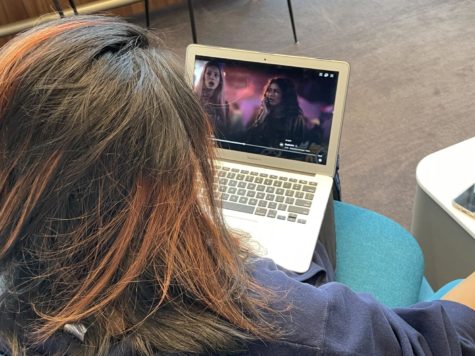Literal highs and twisted lows
‘Euphoria’ depiction of high school may have adverse effects on viewers
March 25, 2022

The term “glorifying” seems to have become a favorite of television critics regarding HBO’s “Euphoria.” The show released its second season earlier this year, which was met with overwhelming popularity and a fair share of backlash.
Critics of “Euphoria” claim the scenes are unnecessarily graphic and glorify drug abuse and sex addiction. Advocates of the show argue that it simply provides a raw and honest look at the grim realities of teenage life. Neither interpretation may be entirely wrong.
Star of the show Zendaya said in an Entertainment Weekly interview that the show isn’t meant to be a “moral tale,” but to help those who struggle with similar things feel less alone. With 46.6% of teenagers reporting having taken drugs as of 2020, according to the National Center for Drug Abuse Statistics, “Euphoria” may very well accomplish that purpose. The show also tackles more than drug use, addressing the characters’ poor mental health, self-destructive natures and strained relationships. This content can be relatable and comforting to those who watch.
Fans of the show have introduced what many call the “Euphoria aesthetic,” referring to vibrant makeup looks and fashion that reflects the characters and style of the show. By itself, the so-called aesthetic is relatively harmless and can be a fun and creative way for teenagers to express themselves and relate to each other. However, this trend may shed light on the bigger problem—“Euphoria” has created an atmosphere that viewers try to mimic.
While it’s true that the characters’ lives are hardly glamorous and their stories may even educate viewers on drug addiction, the glorification of drug use doesn’t come from the plot of the show. Instead, the potential danger of “Euphoria” comes from the cinematography and appearances of the characters. Even as the characters overdose, the image on the screen is an enticing mixture of attractive lighting and music that not only masks the severity of the problem but can subconsciously make the characters appear more glamorous than they really are.

Another potential problem with the show arises from the age and consequent susceptibility of the viewers. Though “Euphoria” is rated TV-MA, there is little to stop younger audiences from accessing the show on HBO or even pirating it on illegal websites. According to Frontiers in Psychology, exposure to inappropriate content can influence young viewers’ minds in three ways—perception bias, desensitization and imitation.
The first is perception bias, where one’s perception of the real world may evolve into one closer to the content on their screen, developing sexually permissive attitudes or expecting others to behave inappropriately. The portrayal of high school in “Euphoria” as a drug and sex-filled environment may lead younger teenagers to act similar to the characters in an attempt to fit in.
The second influence is desensitization, where viewers may become more tolerant of inappropriate behavior or less empathetic towards those with similar struggles to the characters such as drug addiction.
Lastly, a younger audience may experience imitation, where they mimic the actions of role-model influences such as a movie star playing the main character. According to studies cited in the Frontiers in Psychology article, children exposed to more sexual content in media tended to be more sexually active at an earlier age.
“Euphoria” treads the line between bold and excessive, between brutally honest and sensationalized and between spreading awareness and glorifying dark topics—and it’s important that viewers are able to distinguish between each side. When watching TV, understand that even shows created to spread awareness are ultimately works of fiction intended to keep viewers interested.
In that pursuit, many shows may utilize attractive cinematography and overly glamorous lifestyles that can subconsciously make harmful topics seem more appealing. While there’s no need to stop watching these shows altogether, recognizing the psychological impacts can keep viewers from being negatively impacted by the content they watch.






